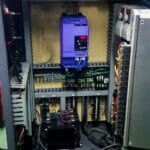New solution offers real-time synchronization between all automation equipment, including robots, vision components, drives, and safety equipment.
OMRON, a global leader in automation technology, has announced the launch of the world’s first*¹ “Robotic Integrated Controller”, the new NJ501-R, based on OMRON’s industry leading NJ series of machine controllers for industrial automation.
With the integrated controller, it is possible to automate advanced and complex manual work and simulate the design and modification of production facilities in a virtual environment, and conduct maintenance remotely.
The new machine controller offers real-time synchronization between all automation equipment, including robots, vision components, drives, and safety equipment.
Improving the speed and accuracy of production, users can simulate entire production lines without having to deploy physical equipment. This will simplify maintenance, and reduce time-to-market during the design, planning, commissioning, and changeover processes.
Many industries are facing labor shortage issues, and the world is experiencing a major turning point with how society conducts business due to new global health concerns. As a result, the demand of more advanced automation with robots has increased, along with a growing demand for digitalization.
Traditionally, automation equipment for production facilities has been controlled by a number of different controllers creating a major challenge to setup and coordinate the speed and timing between various devices. Also, it was very difficult to verify a process design in advance and with a high level of accuracy prior to construction of a machine or larger production line. After the equipment is commissioned, adjustments need to be made onsite and backtracking and specification changes are common, resulting in a huge number of man-hours.
As a manufacturer of motion sensors, robotics, and safety equipment for fully automated production lines, OMRON has now addressed these issues by seamlessly integrating the control equipment.
Integration of control and the construction process
The “Robotic Integrated Controller” automates inserting and assembling processes that require delicate and skillful processing. The robots and equipment are controlled and fully synchronized in real-time by a single controller, improving device performance, and achieving the world’s highest level of throughput*².
OMRON has also unified the programming languages for robot and machine control, making it easy to simulate a production line with single programming software. The system visualizes the process, reducing man-hours for process design and operational verification by up to 50%*³. Furthermore, all of this can be conducted remotely. Through Sysmac Studio’s user interface, users can design, program, troubleshoot, operate and maintain future automation systems remotely from anywhere in the world.
Key features and benefits of the Integrated Controller:
- By integrating the PLC, motion, and robot control in a single controller, complex manual work that could only be conducted by humans can now be completed by robots.
- The programming language for the PLC and robot is unified in the generic IEC language, which allows engineers who typically manage PLCs the ability to also manage robots as well.
- With OMRON’s simulation technology, you can verify equipment performance at the early stage of equipment design, allowing mechanical designers and electrical designers to design in parallel. As a result, equipment commissioning can be completed in a shorter period, higher production capacity can be achieved, and mistakes and setbacks during equipment commissioning can be avoided.
- To run the simulation, the user can use the emulation function in Sysmac Studio. The system does not require a connection to the actual machine for operation verification. Also, the production capacity of the robot equipment can be monitored digitally.
- By re-using previous digitalized assets, it is easier to establish the next facility.
*¹ The world’s first: November 2019, according to the OMRON research.
*² Highest level: November 2019, according to the OMRON research.
*³ 50%: July 2020, according to the OMRON research.
About “innovative-Automation”
As a leader in industrial automation, OMRON has extensive lines of control components and equipment, ranging from image-processing sensors and other input devices to various controllers and output devices such as servo motors, as well as a range of safety devices and industrial robots. By combining these devices via software, OMRON has developed a variety of unique and highly effective automation solutions for manufacturers worldwide. Based on its reservoir of advanced technologies and comprehensive range of devices, OMRON set forth a strategic concept called “innovative-Automation” consisting of three innovations or “i’s”–“integrated” (control evolution), “intelligent” (development of intelligence by ICT), and “interactive” (new harmonization between people and machines). OMRON is now committed to bringing innovation to manufacturing sites by materializing this concept.
About OMRON
OMRON Corporation is a global leader in the field of automation based on its core technology of “Sensing & Control + Think.” OMRON’s business fields cover a broad spectrum, ranging from industrial automation and electronic components to automotive electronic components, social infrastructure systems, healthcare, and environmental solutions. Established in 1933, OMRON has about 30,000 employees worldwide, working to provide products and services in around 120 countries and regions. In the field of industrial automation, OMRON supports manufacturing innovation by providing advanced automation technology and products, as well as through extensive customer support, in order to help create a better society. For more information, visit OMRON’s website: https://www.omron.com/.








